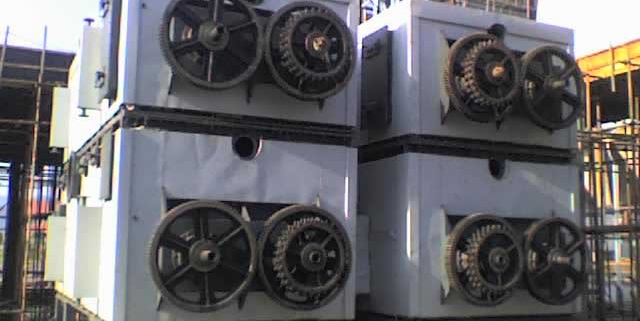In industrial production, due to the shape of the material to be dried (block, granular, solution, slurry and paste), and properties (heat resistance, water content, dispersibility, viscosity, acid and alkali resistance, explosion-proof and The production scale or production capacity varies greatly depending on the humidity, etc. The requirements for dry products (such as water content, shape, strength and particle size) are also different. Therefore, the types of industrial drying equipment used are also various. .
Box drying equipment, also known as disc drying equipment, is one of the oldest drying equipment for intermittent operation at atmospheric pressure. Generally small is called an oven, and large is called an oven. According to the way of gas flow, it can be divided into parallel flow, through flow and vacuum.
The parallel flow drying device is placed in the shallow tray on the tray 7, and the accumulated thickness of the material is about 10 to 100 mm. The fresh air sucked by the fan 3 is preheated by the heater 5 and uniformly sweeps across the surface of the material in each shallow tray along the baffle 6 to dry the material. Part of the exhaust gas is discharged through the discharge pipe 2, and the remaining cycle is used to increase the heat efficiency. The amount of exhaust gas circulation is regulated by a baffle of the suction port or the discharge port. The flow rate of the air depends on the particle size of the material, and the material should not be taken out of the drying equipment by the airflow. The principle is generally 1 to 10 m/s. The platter of the drying device can also be placed on the movable trolley frame to facilitate loading and unloading of materials and reduce labor intensity.
If there are special requirements for the drying process, such as drying heat sensitive materials, flammable and explosive materials or the moisture content of the materials need to be recycled, the box drying equipment can be operated under vacuum, which is called box vacuum drying equipment. The drying compartment is sealed, the shallow tray is made hollow, and the heated steam passes through. When drying, the material is heated in a conductive manner to vaporize the moisture or solvent of the material in the tray, and the vaporized vapor or solvent vapor is extracted by a vacuum pump. To maintain the vacuum inside the car.
The material flowing through the flow drying device is laid on a porous shallow plate (or mesh), and the air flow passes vertically through the material layer, and a slanted baffle is arranged between the two materials to prevent the humid air blown from the layer of material. Blow into another layer. The velocity of air through the orifice is about 0.3 to 1.2 m/s. The through-flow drying equipment is suitable for ventilated granular materials, and the drying rate is usually 8 to 10 times that of cocurrent.
The box drying device can also use flue gas as a drying medium. The advantage of the box drying equipment is that the structure is simple, the equipment investment is small, and the adaptability is strong. The disadvantage is that the labor intensity is large, the heat loss of the loading and unloading materials is large, and the product quality is not easy to be uniform. Box drying equipment is generally used for drying small quantities and varieties of materials, especially for laboratory applications.
Belt drying equipment, the drying chamber has a rectangular cross section, and a mesh conveyor belt is installed inside. The material is placed on the conveyor belt, and the air flow and the material flow in a wrong flow. During the forward movement, the material is continuously contacted with hot air to be dried. The conveyor belt may be a single layer or a plurality of layers, having a bandwidth of about 1 to 3 m, a belt length of about 4 to 50 m, and a drying time of about 5 to 120 minutes. It is usually divided into a number of sections in the direction of movement of the material, and each section can be equipped with a fan and a heater. In different sections, the direction, temperature, humidity and speed of the airflow can be different. For example, in the wet section, the operating air velocity can be larger.
Depending on the nature of the material being dried, the conveyor belt can be made of canvas, rubber, rubberized cloth or wire mesh. The material can be kept in the original state in the belt drying equipment, or a plurality of solid materials can be continuously dried at the same time, but the pile thickness and the loading density of the materials are required to be uniform, otherwise the unevenness of the ventilation may result in a decrease in product quality. The drying equipment has low production capacity and thermal efficiency, and the thermal efficiency is about 40% or less. Belt drying equipment is suitable for drying granular, bulk and fibrous materials.
In addition, according to the structure of the vibrating screen, the commonly used dryers are: spray vibrating screen, fluidized bed vibrating screen, air flow vibrating screen, rotary cylindrical vibrating screen, drum vibrating screen, infrared vibrating screen, high-frequency vibrating screen, etc. These vibrating screens have been widely used in the feed drying industry, which greatly supports the development of the feed industry.
New microwave drying equipment features
1. Selective heating. Since water molecules are best for microwave absorption, the portion with a high water content absorbs more microwave power than the portion with lower water content. This is the characteristic of selective heating, which allows uniform heating and uniform drying.
2. Energy efficient. The microwave acts directly on the material, so there is no additional heat loss, the air in the furnace and the corresponding container will not heat, so the thermal efficiency is extremely high, the production environment is also obviously improved, and the electricity can be saved by 30% compared with the far infrared heating. .
3. Short time and high efficiency. Microwave heating is a process in which the object to be heated itself becomes a heating element and does not require heat conduction. The microwave penetrates the inside and outside of the object from all sides and simultaneously achieves uniform heating in a short time, which greatly shortens the drying time.
4. Microwave drying equipment is easy to control, advanced technology. Compared with the conventional method, the device is ready to use; without thermal inertia, the operation is flexible and convenient; the microwave power is adjustable, and the transmission speed is adjustable. In microwave heating, drying, no waste water, no waste gas, is a safe and harmless high-tech.



